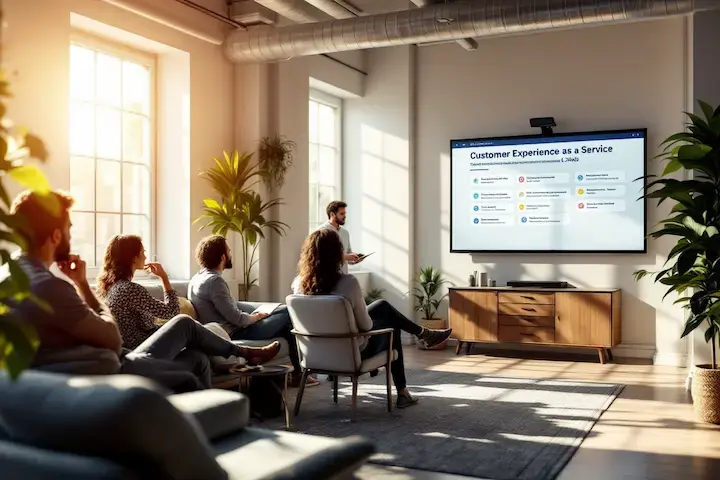Automation is a hot topic these days. Every business, regardless of size or industry, grapples with repetitive tasks that can bog down productivity—even at the executive level. Research shows employees spend 10–25% of their time on manual, repetitive tasks, highlighting significant opportunities for automation. These routine activities drain valuable resources, distracting teams from strategic initiatives that fuel growth and enhance customer experience. You know there's a better way, but figuring out where to begin can feel daunting.
Generative AI has dramatically accelerated the pace and potential of automation, unlocking complex tasks, personalized customer interactions, and deeper insights. Yet, this rapid expansion has also introduced many immature and ineffective products into the market. It’s essential to approach automation thoughtfully, considering collaboration with experienced professionals—like Win with CX—to architect solutions tailored specifically to your needs.
With countless tech companies promising to automate your business from top to bottom, it's easy to feel overwhelmed. I regularly hear from founders and business development representatives eager to demo their latest tools. But automating everything isn't practical—or even necessary. A smarter approach is strategic automation: tackle it one step at a time, prioritizing what matters most to your business and customers today.
Here's your step-by-step guide to identifying where to start.
Step 1: Define Your Automation Goals
Before diving into automation, it's essential to clarify what you aim to achieve. Are you looking to:
- Reduce human error?
- Speed up response times?
- Improve customer service and experience?
- Free up your team's time for higher-value tasks?

Identify your most pressing needs and align them with your business objectives and customer expectations. This clarity will guide your automation efforts and help measure success in both operational efficiency and customer satisfaction.
Step 2: List Out Your Processes
You can't automate what you haven't identified. Begin by listing out all your business processes. Reference your existing customer journey maps or service blueprints to help pinpoint the operations that directly or indirectly impact your customers. These tools offer valuable insights into every touchpoint and interaction, making it easier to identify processes ripe for automation.
If you don't already have customer journey maps or service blueprints, it's a good idea to get started on them—not just for automation, but to enhance overall agility and understanding of the customer experience. You can’t improve what you can’t measure, and you can’t measure what you can’t see.
When listing your processes, be specific:
- Instead of "customer follow-up," note tasks like "responding to transactional surveys" or "sending CSM check-in emails."
- Break down each process into individual steps to uncover automation opportunities that can enhance the customer journey.
Highlight tasks that meet one or more of these criteria:
- High-volume, repetitive tasks (daily or weekly)
- Tasks with clearly defined rules and procedures
- Processes that cause delays or bottlenecks affecting customer experience
By thoroughly listing out your processes and referencing customer journey maps or service blueprints, you'll have a comprehensive view of where automation can make the most significant impact.
Step 3: Prioritize Using the Eisenhower Matrix
With your list in hand, it's time to prioritize. An adapted version of the Eisenhower/Covey Matrix is a classic tool for this. Originally designed to help with time management by categorizing tasks based on urgency and importance, we can adapt it for automation:
- Quadrant 1 (High Impact, Low Complexity): Quick wins—automate these first, especially if they directly improve customer interactions.
- e.g. A retailer we’re working with automated their customer appointment reminders via text, which reduced no-show rates by 20% and saved staff several hours per week.
- Quadrant 2 (High Impact, High Complexity): Plan and allocate resources—these are valuable but may require more effort. Prioritize those that significantly enhance customer satisfaction.
- Quadrant 3 (Low Impact, Low Complexity): Automate if resources allow—these won't move the needle much but are easy to implement.
- Quadrant 4 (Low Impact, High Complexity): Avoid—these are not worth the investment right now.

If you're unsure how to assess the complexity or impact of automating a task, consider the following steps:
- Use an Automation Cost-Benefit Calculator: Input parameters like task duration, employee hourly rates, and frequency to estimate potential annual savings and improvements in customer experience.
- Consult with Outside Experts: If you're uncertain about how to gauge the complexity or potential benefits of automating a particular process, partnering with automation specialists can provide valuable insights. Experts can help evaluate your processes, recommend the best tools and strategies, and ensure that your automation initiatives align with your business goals and enhance the customer experience. Reach out if you need help. If WwCX isn’t the right fit, I’ll work to connect you with someone that is.
- Pilot Testing: Start with a small-scale implementation to assess the complexity and impact firsthand. This approach allows you to learn, gather data, and solicit feedback, helping you make informed decisions about scaling automation efforts. This is the approach I encourage for most companies and applies to generative AI and automation solutions.
Many of today’s best practice frameworks (like those from Forrester or McKinsey) advise starting automation efforts where they can improve customer journeys, because that often yields revenue growth or loyalty benefits, not just cost savings. By leveraging these methods, you can more accurately prioritize tasks and ensure that your automation efforts deliver maximum value to both your business and your customers.
Step 4: Explore Automation Approaches
Now that you've prioritized, decide how to implement automation. There are two main routes:
Build Your Own with an Automation Platform
Building your own automation allows for a high degree of customization to fit your specific business needs and customer expectations. This approach leverages no-code or low-code platforms, enabling you to create tailored automation workflows without extensive programming knowledge.
- Platforms and Tools:
- n8n: An open-source workflow automation tool that you can self-host(they also provide cloud hosted solutions). Self-hosting provides enhanced privacy and security, allowing you to integrate your own generative AI models. This means you can automate processes while maintaining control over customer data, enhancing trust and compliance.
- Zapier and Make: Cloud-based platforms that offer extensive app integrations. They enable you to automate tasks like sending personalized emails or updating customer records in real-time, improving the customer experience.
- Robotic Process Automation: For tasks that involve legacy systems or where a human currently toggles between multiple applications, Robotic Process Automation (RPA) tools (like UiPath or Automation Anywhere) could be used to mimic those actions. This is especially useful if no ready integration exists – the ‘robot’ can perform the clicks and data entry just as a person would
- Benefits:
- Customization: Tailor workflows to meet specific customer needs and preferences.
- Enhanced Privacy: By integrating your own AI models, you ensure customer data remains secure.
- Scalability: Start small and expand as you identify more ways to enhance customer interactions.
Leverage What You Got
For years, companies like Salesforce and Microsoft have offered robust automation solutions, now enhanced with generative AI through products like Salesforce’s Agentforce and Microsoft’s 365 Copilot. These tools enable intelligent, personalized automation, boosting operational efficiency and customer experience.
However, many businesses struggle with underutilization of existing technology investments, missing opportunities to improve customer satisfaction and ROI. Maximizing these tools involves:
- Audit Your Current Tools: Identify and activate unused features that enhance customer interactions, such as automated follow-ups or AI-driven support.
- Training and Onboarding: Ensure your team is trained to fully utilize these tools, transforming customer service and operational efficiency.
- Vendor or Partner Services: Work with third-party services or experts to customize your software solutions, directly benefiting your customers.
Buy Pre-Built Solutions
The market is flooded with new automation and generative AI solutions, some tailored to specific industries and integrating well with existing tools, while others may be less reliable ("snake oil"). To navigate this:.webp?width=306&height=460&name=Automation%20Goals%20(1).webp)
- Existing Software Vendors: Explore additional automation and AI offerings from your current software providers for a cohesive strategy.
- Industry-Specific Solutions: Consider tools designed for your industry that address unique challenges and requirements.
- Integration Capabilities: Ensure new solutions integrate smoothly with your current technology stack to maintain workflow continuity.
- Vendor Reputation and Product Maturity: Assess the credibility and reliability of new solutions through reviews, case studies, and testimonials.
Leverage Generative AI Solutions
- Sentiment Analysis: Implement AI tools to analyze customer feedback for reviews, surveys, and interactions.
- Personalized Customer Interactions: Use AI-driven chatbots for instant, personalized responses.
- Enhanced Decision-Making: Analyze customer data with AI to gain insights that improve products and services.
- Automatic Support Ticket Classification and Next Best Action: Leverage AI powered tools to classify incoming support requests and suggest follow-up, action steps, and customer communication.
As you see positive results, progressively tackle the next set of priorities, always considering how each automation will affect your customers.
By fully leveraging the automation and AI capabilities of pre-built solutions, whether by maximizing existing tools or selecting new, reliable ones, you can enhance efficiencies and customer satisfaction without additional investments. Partnering with outside experts can help architect tailored solutions, ensuring you maximize your technology investments and achieve substantial ROI. Reach out so see if we can help. If we’re not the right fit, I am confident we can recommend someone that is.
Step 5: Implement in Stages
Resist the temptation to overhaul everything at once. Start small:
- Begin with tasks in Quadrant 1 of your Eisenhower Matrix, focusing on those that will have the most significant impact on customer experience.
- Monitor implementation closely, noting time, effort, and resources used.
- Gather feedback from team members and customers to assess the effectiveness of the automation.
As you see positive results, progressively tackle the next set of priorities, always considering how each automation will affect your customers. Implement-Get Feedback-Improve for continuous improvement (Kaizen).
Change Management and Governance
Address employee concerns proactively. Communicate clearly, involve your team early, and frame automation as enhancing rather than replacing roles. Identify and leverage “Change Champions” within your teams. Establishing lightweight governance or an Automation Center of Excellence (CoE) early on can help guide automation effectively.
Step 6: Monitor and Adjust
Automation isn't a "set it and forget it" solution. Ongoing oversight ensures:
- Monitor the customer experience to understand how the introduction of automation has impacted their experience.
- Processes are working as intended and enhancing customer satisfaction (or at least not eroding it).
- Make data-driven adjustments to pinpoint areas for improved efficiency and the customer experience.
- ROI is tracked, justifying the investment and its impact on customer retention and loyalty.
- Ongoing Change Management and Governance to ensure adherence to standards, security, and alignment with strategy.
Collect data on time saved, error reduction, and customer feedback to measure the impact accurately. A future post will offer a deeper dive into developing and managing effective KPIs.
Additional Tips
- Start Simple with No-Code Tools: Platforms like n8n, Zapier, and Make allow you to automate without writing code. They're user-friendly and can be used to improve customer interactions quickly.
- Incorporate AI Wisely: AI can enhance automation, especially in data analysis and customer interactions. Use it to augment—not replace—human expertise, ensuring a personal touch remains in customer service.
- Monitor Employee Workloads: Automation should alleviate burdens, not create new ones. Ensure your team is adapting well and can focus more on strategic initiatives that enhance the customer experience.
- Stay Focused: The tech world is full of shiny new tools. Stick to your plan and avoid getting sidetracked until you're ready to expand, ensuring consistency in the customer experience.
- Hyperautomation Vision: Aim to evolve your automation strategy into hyperautomation, combining multiple tools and technologies like AI and RPA to handle increasingly complex tasks. Basically a plan to use a combination of technologies to automate broadly and deeply.
By systematically identifying and prioritizing automation opportunities, you can streamline operations, reduce costs, and free up your team to focus on what truly matters—growing your business and delighting your customers. Remember, automation is a journey. Start with manageable steps, learn and adapt, and you'll build momentum over time. Then, continue to iterate until you've optimized your entire process landscape, all while keeping the customer at the heart of your business.


.png?width=70&name=Dreamwave-Photo%20(8).png)

.webp)
